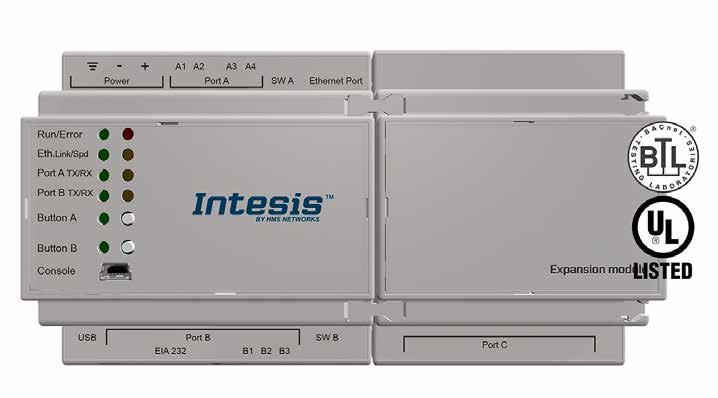
25 minute read
New Products
Protocol translator integrates between EtherNet/IP & BACnet IP/MSTP-based building management systems.
Many processes in a factory are depending on proper monitoring and control of the building where the factory equipment is installed. In the same way, lighting in the building can be aligned with working hours to reduce energy waste or to improve the management of emergency situations.
With the new Intesis protocol translator from HMS Networks, system integrators can easily integrate any Ethernet/IP-based PLCs, such as Rockwell Allen-Bradley PLCs models, with any BACnet BMS. The With a capacity of up to 1200 data points, the gateway is a BACnet IP/MSTP server/slave on one side and an EtherNet/IP adapter on the other, featuring independent Ethernet ports. The gateway has been BTL-certified for BACnet and carries the UL mark in order to guarantee the highest communication and quality standards. It is also ODVA pre-certified thanks to its inbuilt Anybus CompactCom module.
A free Intesis MAPS configuration tool for all Intesis protocol translators offers a very intuitive configuration process for system integrators. With MAPS, integrators are helped further in their projects by providing valuable EDE files for the BACnet integration, as well as EDS files and configuration reports for usage in EtherNet/IP PLC configuration tools like Rockwell´s Studio 5000 software.
Extending the new Intesis Factory-toBuilding protocol translator family, the new EtherNet/IP - BACnet gateway is another example of HMS combining technologies. In the gateway, Anybus CompactCom and Intesis communication technologies are used for industrial and building-oriented communication respectively, both proven in millions of installations worldwide.
New gateway offers bi-directional communication between EtherNet/IP PLCs and BACnet controllers.
HMS Networks
Visit Website
Expanded line of industrial RTUs
A rugged, flexible solution for monitoring and control in extreme environments
Red Lion Controls announces the expansion of its SixTRAK line of industrial RTUs with the launch of STIPm-8460 powered by the Red Lion Workbench, which uses an IEC61131-3 compliant editor and runtime engine. Designed for applications that need increased processing and communication speed and storage, the new RTU provides the flexibility and reliability that customers require and expect from Red Lion to monitor and control equipment.
The ability of the ST-IPm-8460 to operate in harsh and hazardous locations is achieved through UL Class I, Div certification, an ABS listing, and an operating temperature range of -40°C to 70°C.
The combination of ST-IPm-8460 and Red Lion Workbench can easily support large, complex projects across multiple devices. The Red Lion Workbench provides customized control, standard language support, powerful debugging/monitoring tools, project automation, and controller redundancy.
Whether an application monitors a few data points or thousands, the ST-IPm-8460 can be easily configured to meet the needs using Red Lion’s EtherTRAK-2 I/O modules.
Available for private labeling, the ST-IPm8460 also offers dual power inputs and support for redundant Ethernet networks for increased uptime, while a multitude of communication ports and supported protocols enable connectivity to a variety of field devices.
The technologies enable customers worldwide to gain real-time data visibility that drives enhanced productivity.

Maxim MAX78000 incorporates two 32-bit microcontroller cores & ultra-low-power accelerator in a single package.
Red Lion Controls
The smartLink HW-DP gateway provides controller-independent access to PROFIBUS DP networks.
Industry 4.0 connectivity is available for new and existing PROFIBUS DP networks. This compact tool can be integrated without affecting the operation of existing installations and therefore enables Industry 4.0 connectivity for a wide variety of PROFIBUS DP installations.
The smartLink HW-DP V1.01 enables access to process, asset, and diagnostic data from PROFIBUS devices and HART devices connected to PROFIBUS remote I/Os. Furthermore, it allows for secure data export to any system inside and outside the company's own network.
Users in the process industry who want to adapt their communication architecture to modern IoT use cases can integrate smartLink into existing plants in a simple and costeffective manner.
The data which is relevant for optimization processes is made available via open, standardized interfaces such as HART IP and FDT for subsequent applications This means that any HART IP clients, such as Emerson's AMS Device Manager or the Android app DevComDroid, can be used to set parameters for, monitor and evaluate field devices via these open communication standards.
Key features include configuration, parameterization and plant asset management using standard industry tools: • Independent of configuration tools • Centralized parameterization of PROFIBUS and HART field devices directly from the control room using HART IP and HART over PROFIBUS • Access to Plant Asset Management applications for field devices configuration based on FDT/DTM and
EDDL standards (acyclic master)

The smartLink gateway enables easy integration of Industry 4.0 applications into PROFIBUS & HART systems.
Softing Industrial Automation
Visit Website
First type R Profinet robot cable
ETHERLINE ROBOT PN Cat.5e cable complies with new type R standard for PROFINET cables on robots.
Until now, robot application designers have had to decide whether to use a data cable for linear, horizontal travel distances, typical in cable chains, or a data cable that is better suited for torsion. The main reason is that the cable types have a different interior structure.
While relatively short lay lengths are preferred for cables for horizontal travel distances to achieve lower bending radii in the cable chain, long travel lengths are a priority for torsion cables.
A large number of conventional Ethernet cables have not been able to properly cope with this combined challenge. Furthermore, there were no uniform industry standards for robot-compliant Ethernet data cables. The PROFINET user organisation has now drawn up the necessary specifications in close consultation with AIDA (the Automation Initiative for German Motorists).
The new “type R” describes two-pair Cat.5e industrial data cables, which must withstand numerous electrical and mechanical requirements and provide longevity when used in industrial robots. The mechanical requirements are enormous. A type R-compliant cable must endure all of these tests before it is ranked as a robot-compliant cable according to PROFINET: 5 million vertical torsion cycles at ±180° per metre, 5 million cycles in the horizontal cable chain at accelerations of up to 10 m/s² and speeds of 3 m/s over a travel distance of 5 m, an additional 1 million bends in the alternating bending test according to EN 50396 at a bending radius of just 7x outer diameter.

Ethernet cables used in industrial robots need to withstand torsion paired with horizontal linear movements.
Lapp
Ixxat SG-gateways enable communication between industrial automation devices and energy networks.
The Ixxat SG-gateway line offers new versions including a 4G/LTE modem for cellular connectivity as well as 4-port Ethernet switching capabilities, giving users energy networking options for substations and power plants.
For energy networking use cases including mini-RTU, gateway and remote access, Ixxat SG-gateways are used in energy automation, e.g. in modern power plants and in large scale energy consumer installations.
The SG-gateways are used for different purposes, and can connect energy control networks with industrial automation devices, enable remote access, act as gateways between different protocols and enable the development of IIoT applications.
With the new, integrated 4G modem and extensive protocol support, the Ixxat SG-gateways are designed for easy digitalization of small, outlying energy distribution stations.
The 4G CAT1 connection offers 10 Mbps downstream and 5 Mbps upstream communication with low latency, high network coverage and a universal data channel–independent of wired Ethernet, DSL or fiber optics. 4G can be used as either the main or backup communication channel.
All supported IP-based protocols, including IEC 61850, IEC 60870-5-104, MQTT and OPC-UA, can be transmitted over the wireless link.
The 4G modem can also be used as an independent communication channel for e.g. device maintenance and alarm messages (SMS or MQTT), enables straightforward implementation of predictive and remote maintenance applications.

Data exchange simplified between energy automation networks and industrial Ethernet systems.
Ixxat
Visit Website
AI and machine learning applications
Mouser has expanded its range of products and resources aimed at developers of AI and IoT solutions.
New products include a machine vision development kit from ADLINK suitable for industrial applications, a low-power dual-core processor with neural network accelerator from Maxim Integrated for use in batterypowered IoT devices, and a face recognition development kit from NXP Semiconductors.
The ADLINK Technology Vizi-AI machine vision AI development kit comprises a SMARC computer module based on an Intel Atom processor and an Intel Movidius Myriad X vision processing unit (VPU). Software support includes the Intel OpenVINO software development kit, which includes several ready-to-use, pre-built machine learning models. A collection of ADLINK neural model development tools is also included. With the kit, developers of industrial machine vision applications can rapidly prototype solutions that detect production line problems and deliver actionable insight to improve operational efficiencies.
The Maxim MAX78000 processor incorporates two 32-bit microcontroller cores and an ultralow-power network accelerator in a single package. The microcontroller cores, one an Arm Cortex-M4 and the other a RISC-V co-processor, provide system control and fast loading of the 442-kByte weight convolutional neural network. The device is highly optimised for battery-powered IoT edge devices and is capable of conducting inference 100 times faster and consuming 1/100th of the power of conventional microcontroller devices. An evaluation kit for the MAX7800 is also available.
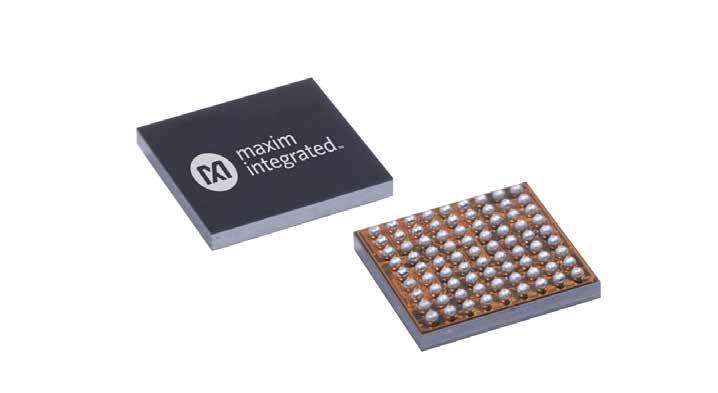
Maxim MAX78000 incorporates two 32-bit microcontroller cores & ultra-low-power accelerator in a single package.
Mouser
The first WiFi 6E router from NETGEAR delivers high-speed WiFi with support for the 6 GHz band.
With the Nighthawk RAXE500, the company has announced its first WiFi 6E router. With speeds of up to 10.8 Gbit/s, the latest addition to the Nighthawk series heralds a new era of fast connections on the new 6GHz band that is free of interference and overload.
Until the introduction of WiFi 6E, wireless routers were limited to the 2.4GHz and 5GHz bands. The new WiFi 6E WiFi standard solves these congestion problems by adding a previously unavailable 6GHz WiFi band that can be used to transmit WiFi signals and connect to a wide variety of devices with faster speed and reliability.
The new third 6GHz band will dramatically increase the capacity of networks to support more devices simultaneously. "The proliferation of WLAN applications in the last few decades initially claimed the 2.4 GHz band and then finally the 5 GHz band with WiFi 4, 5 and 6," explained Phil Solis, Research Director at IDC. "With the opening of the 6GHz band by regulators around the world, WiFi 6E networks will give devices the leeway they need to use large channels with higher average data rates and lower latency even in dense and congested areas."
With this latest technology, the new WiFi 6E router expands the home WLAN many times over for more performance, capacity and experiences in a new world of uninterrupted connectivity.
Simultaneous remote learning, video conferencing and 4K / 8K video streaming are no longer a problem. With the new 6GHz band, the new Nighthawk RAXE500 offers faster speeds, smoother streaming, less interference and improved latency for devices and WiFi -hungry applications.

New era of fast connections is available on a 6GHz band that is free of interference and overload.
NETGEAR
Visit Website
TSN Gigabit Ethernet PCIe NIC solution
The combination of TSN with OPC UA provides key technology to realize the IIoT.
ASIX has launched a new TSN product, AXM57104 Quad Port TSN Gigabit Ethernet PCIe NIC Card, which can help converge IT and OT networks for industrial communication applications.
The AXM57104, compliant to PCI Express base spec. v2.1 Gen1, supports enhanced TSN functions included the timing and synchronization compliant to IEEE 802.1 AS-Rev/AS and IEEE 1588V2, the Forwarding and Queuing of Time Sensitive Streams (FQTSS). It specifies Credit-Based Shaper (CBS) compliant to IEEE 802.1Qav, the Time-Aware Shaper (TAS) compliant to IEEE 802.1Qbv, and the Per-Stream Filtering and Policing (PSFP) compliant to IEEE 802.1Qci. AXM57104 also supports 32 synchronous I/O pins, one pulse per second (PPS) output and is field upgradable via In Application Programming.
The AXM57104 is a cost-efficient PCIe to TSN solution for IIoT applications to enable TSN functions on industrial automation platforms, Fieldbus over TSN gateways and converge the non-real-time IT network and real-time OT networks including industrial Ethernet protocols such as EtherCAT, PROFINET, EtherNet IP, etc.
Time Sensitive Networking (TSN) technology is a set of IEEE 802.1 standards under development by the IEEE TSN Task Group and is an OSI model Layer 2: Data Link Layer (DLL) communication technology. TSN provides hard real-time, deterministic, and low latency capabilities on standard Ethernet to meet the real-time data transmission requirements for industrial communication.

Cost-efficient PCIe to TSN solution for IIoT applications to enable TSN functions on industrial automation platforms.
ASIX
Industrial PCs offer powerful technology, modular extendibility and integrated Profisafe functionality.
With its all-in-one solutions, Phoenix Contact offers industrial PCs with a completely closed die-cast aluminum housing (IP65), designed for modern operating concepts.
The latest sensor generation makes it possible to operate the screen even when wearing thick gloves. The glass surface increases the robustness of the capacitive technology with regard to aggressive cleaning agents and sharp objects.
Displays with full HD resolution offered in 15.6-inch, 18.5-inch and 21.5-inch versions facilitate the visualization of simple sequences up to complex production processes, while specific details can be displayed via gesture control. The AIO devices contain powerful Intel Core i5 processors so that they are capable of implementing tasks that are very demanding, such as machine control, process visualization, or quality assurance. The AIO devices are space-saving, as their completely closed housings eliminate the need for additional casings. The screw holes on the rear of the housing are dimensioned according to the VESA-100 standard, which makes it possible to mount the device directly to the machine or system. It is also possible to install the device on a support arm or stand using the appropriate rear cover. Upon request, a keyboard module can be used to expand the industrial PCs by up to 11 buttons or switches, which can be used for USB connections, key switches, or other functions. If the user would like to incorporate the operating solution into an existing Profinet network, a gigabitcapable switch with Profinet and Profisafe function is available to forward the data. A signal light can also be easily integrated into the operating concept.

Despite high-performing CPUs, industrial PCs are designed to be fanless, increases their range of applications.
Phoenix Contact
Visit Website
Edge computing package
Crosser and TTTech Industrial announced partnership to offer customers a unique edge computing package.
Crosser’s edge analytics software is available pre-installed on Nerve Blue, the edge computing platform from TTTech Industrial. This bundle simplifies industrial IoT operations by combining software management and powerful streaming analytics with ease of use.
Industrial customers are increasingly searching for ways to access valuable data from their machines without having to overhaul running systems. The goal for machine builders and plant operators is to use this wealth of data in real-time to make significant improvements in productivity and efficiency on the shop floor. The Nerve and Crosser bundle provides a comprehensive platform for connecting machines, analyzing data and remotely managing software. Crucially, these features are available via intuitive user interfaces that require no specialist knowledge.
Together, Nerve and Crosser enable industrial users to develop and scale by rolling-out new services to machines and plants around the world with the click of a button. Users benefit from the inherent flexibility and openness of the platforms, which can be connected to any data source, any service, and any cloud. Additionally, customers are given the freedom by Nerve and Crosser to be truly independent, with the ability to choose hardware or applications from their preferred vendor.
“We are proud to cooperate with TTTech Industrial and Nerve Blue. Together, we truly simplify the journey for industries that strive for digital smartness,” says Crosser’s Director, Mikael Samuelsson.

Bundle simplifies industrial IoT operations by combining software management and powerful streaming analytics .
TTTech Industrial and Crosser
Industrial wireless family has been expanded with the introduction of new access points.
Antaira Technologies’ industrial wireless family has been expanded. The ARS-7235-AC series is an industrial IEEE 802.11a/b/g/n/ac wireless LAN access point with added router capabilities. It is designed for enterprise and industrial wireless applications. The device allows a user to position the wireless antennas in a better signal-broadcasting location for improved wireless coverage and signal strength.
The ARX-7235-AC-PD-T is an industrial outdoor IP67 metal housing IEEE 802.11a/b/g/n/ac wireless access point/ client/bridge/repeater with router capabilities, and is IEEE 802.3af/at PoE PD compliant. It is designed with an extended operating temperature range of -40°C to 70°C for outdoor applications to withstand extreme weather conditions and temperatures.
Antaira’s new ARY-7235-AC-PD is an industrial outdoor IP67 plastic housing IEEE 802.11a/b/g/n/ac wireless access point/ client/bridge with router capabilities, and is IEEE 802.3af/at PoE PD compliant. It is designed for industrial and enterprise wireless access applications. This unit has a standard operating temperature range of -40°C to 50°C, which can withstand harsh environmental conditions such as dust and debris.
No matter which industrial wireless product is chosen, all three wireless devices are embedded with Qualcomm IPQ4029 SoC chipset which has dual band 2.4GHz/5GHz concurrent, and supports high-speed data transmission of up to 867Mbps. In addition, all three wireless products are capable of operating in different modes, which makes them suitable for a wide variety of wireless applications including longdistance deployments.

All three wireless products are suitable for a variety of wireless applications including long-distance deployments.
Antaira Technologies
Visit Website
Edge controllers optimize data usage
In many cases, transferring data from machines and systems directly to a cloud solution is resource-intensive and not feasible due to the low latency often required for industrial applications. Edge computing has established itself because it combines the advantages of decentralized cloud architectures with those using a local network architecture.
Edge devices can take over data mining from controllers that require low latency and a high level of determinism. Collected data can be evaluated directly, displayed graphically and made available to the cloud. WAGO debuts two new edge devices designed for this: the Edge Controller and the Edge Computer.
The new Edge Controller (752-8303/8000- 0002) utilizes an ARM Cortex-A9 quad-core processor and offers an selection of interfaces, including two ETHERNET ports, one CANopen port and two USB ports. It also has a serial interface and four digital inputs/ outputs for connecting local devices or sensors. Project design for the Edge Controller can occur in the familiar e!COCKPIT environment, so it fits seamlessly in WAGO’s automation ecosystem.
The new Edge Computers (752-9400 and 752-9401) feature a 1.91 GHz quad-core Atom processor and are equipped with standard Debian Linux. An SSD disk can be installed to expand the existing 64 GByte flash memory for very large data volumes. Despite their extended temperature range from −20°C to +60°C, the Edge Computers do without a fan and are very compact, simplifying integration. Standard software, such as Node-Red, can be used on all edge devices.
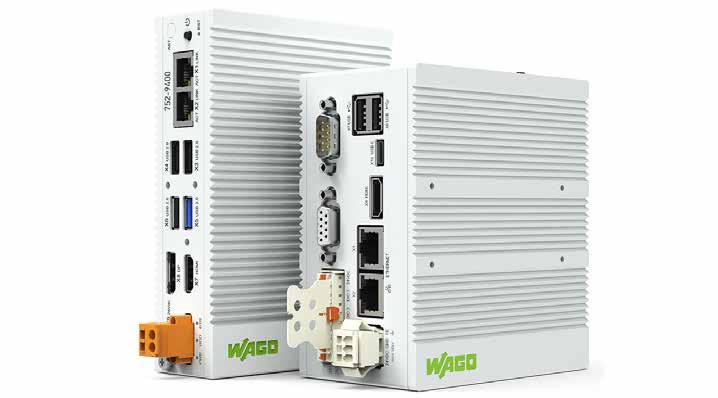
Edge devices can take over data mining from controllers that require low latency and a high level of determinism.
WAGO
MCUs offer best-in-class power consumption combined with flexible power modes for lower average power.
The expansion of Renesas’ 32-bit RA2 Series microcontrollers (MCUs) with 20 new RA2L1 Group MCUs increases the RA Family to 66 MCUs.
The general-purpose RA2L1 MCUs use the Arm Cortex-M23 core operating up to 48 MHz. The RA2L1 MCUs are supported by the easyto-use Flexible Software Package (FSP), which offers software and hardware building block solutions that work out-of-the-box.
The ultra-low power and innovative touch interface of the RA2L1 MCUs are designed for home appliance, industrial and building automation, medical and healthcare, and consumer human-machine-interface (HMI) IoT applications.
The RA2L1 MCUs are designed for ultra-low power consumption, with several integrated features to lower BOM costs, including capacitive touch sensing, embedded flash memory densities up to 256 KB, SRAM at 32 KB, analog, communications, and timing peripherals, and safety and security functions.
In many battery-powered applications, the MCU spends most of the time in a low-power standby mode waiting for an internal or external event to wake-up the CPU and process data, make decisions and communicate with other system components.
When benchmarked for power consumption, the RA2L1 MCU was certified with an EEMBC ULPMark score of 304 at 1.8V, verifying its best-in-class power rating. Users can now minimize power consumption close to the standby levels to extend battery life.
The advanced capacitive touch IP in the RA2L1 MCUs provides enhanced operability for a variety of touch and touchless system implementations.

Ultra-low power and touch interface MCUs are designed for industrial and HMI IoT applications.
Renesas Electronics
Visit Website
WLAN wireless communication adapters
WLAN adapters simplify wireless CPU communication, as well as programming a CPU from a wireless device.
With the compact WLAN adapters WiFi-C and WiFi-Pro from SIGMATEK, efficient wireless CPU communication is enabled. Using the WiFi adapters, the network cable can be easily replaced. Automation can therefore be economically integrated into the existing in-house IT system – if no wired infrastructure is available.
An additional advantage is a simple, comfortable online connection for servicing. The adapters operate in the 2.4 GHz frequency band and can be used worldwide without limitations. The Plug & Play WiFi-C device, which functions as a client, is already available. WiFi-Pro is planned for further development, whereby the adapter can be configured as a client or access point.
The WiFi-C can be easily connected to any existing infrastructure with a wireless router. By connecting to the router with a laptop, all service functions are available – naturally with the usual transmission security and specific password.
When using the WiFi-Pro, you can set whether it is used as a client, as with WiFi-C, or as an access point. With the latter, no additional network is required to create a connection between the control and the laptop as well as tablet or smartphone.
Both variations support the USB A interface. With the integrated engineering platform LASAL, the control can be comfortably programmed over a virtual connection. Readyto-use classes and visualization components for selecting access points as well as entering passwords are available.
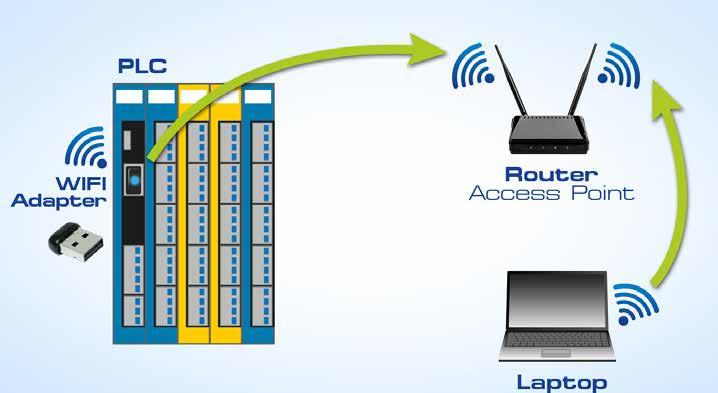
By connecting to the router with a laptop, all service functions are available.
SIGMATEK
Production workers can now more quickly access data using the FactoryTalk Historian Site Edition software.
New enhancements to the latest version of the FactoryTalk Historian Site Edition (SE) software make it the most reliable and secure release of the software to date.
To help users more quickly access data, the software now uses client-side connection balancing and failback. This balances user connections across multiple servers, instead of connecting them all to a primary server.
In larger systems, where many people are making queries for data that can go back several years, this can reduce server demand to help users access data in seconds instead of minutes.
The FactoryTalk Historian SE software also now offers user-based archive scheduling. This function allows users to schedule historical archiving during down periods or off hours. It reduces the risk that archiving occurs during critical processes, when it can affect server performance and slow access to data.
To better secure production data, all subsystems within the FactoryTalk Historian SE software are now configured to run under least-required privileges. This minimizes the potential damage unauthorized users can do if they penetrate a system.
The software also now supports the latest operating systems, such as Windows Server 2019. This can extend the life of systems, which can be especially valuable for operators of validated systems in regulated industries.
The new FactoryTalk Historian SE software release is part of PlantPAx 5.0, the modern distributed control system (DCS) from Rockwell Automation, and uses the same FactoryTalk Services as other software included in the DCS. This minimizes the potential for conflict or errors and helps make installation easier.
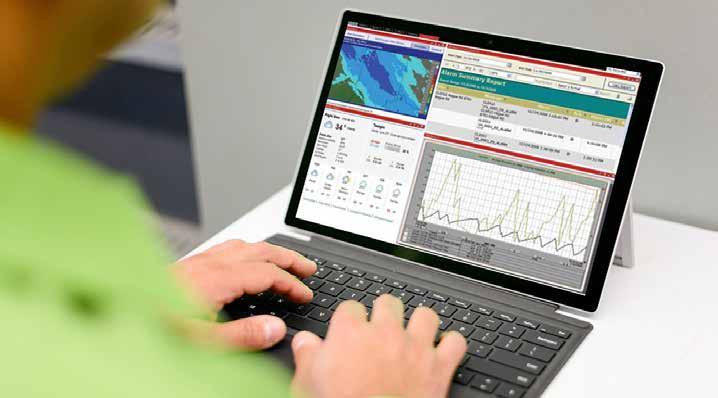
The smartLink gateway enables easy integration of Industry 4.0 applications into PROFIBUS & HART systems.
Rockwell Automation
Visit Website
Radio integrates with 5G RAN software
Integration of radio Unit with Radisys’ 5G NR OpenRAN software enables OpenRAN deployments.
Benetel has integrated its Radio Unit (RU) with Radisys’ 5G NR OpenRAN software to enable OpenRAN deployments for communication, industrial and private network markets. In addition to the new 5G solution, the two companies executed a licensing agreement for Radisys’ LTE software to allow its distribution with Benetel’s eNodeB radio platforms.
The pre-integrated Radisys and Benetel 5G NR solution can be deployed in both Non-Standalone (NSA) and Standalone (SA) 5G modes, providing operators with deployment options. The companies have recently demonstrated a successful 5G SA call over the n78 5G band using the integrated solution.
Radisys has designed its 5G NR software suite to support both NSA and SA, providing an easy migration path from LTE/LTE-Advanced deployments to 5G. It is targeted at mmWave and sub-6 GHz frequencies. Radisys’ 5G NR software suite is compliant with 3GPP Release 15 and O-RAN standards with a strong roadmap to evolve towards Release 16. Radisys also provides 5G Core Network functions as defined by 3GPP.
“Service providers and enterprises want to build their networks with open and disaggregated software and hardware components to reap the benefits of a multivendor ecosystem,” says Munish Chhabra, Head of Software and Services Business, Radisys. “With Benetel, we are providing a pre-integrated OpenRAN solution that enables operator and enterprise customers to accelerate network deployments to deliver new services and generate new revenues.”

The companies have recently demonstrated a 5G SA call over the n78 5G band using the integrated solution.
Benetel
Sitrans CloudConnect 240 provides a second data channel completely independent of the control system.
In the process industry, field instrumentation is a central source of data, when it comes to digitalization. The Sitrans CC240 IOT gateway establishes a second data channel, which makes field level data that was previously hidden available to the user – without adversely affecting the existing control technology.
The system creates a direct connection between the field device and IT or the cloud and reads not only basic process values but also identification, configuration, and diagnostics parameters – for any HART device of Version 5 or later. The system then makes this data available via an OPC UA server or the Siemens MindSphere IoT-as-a-Service solution.
The data is harmonized in line with the Namur Open Architecture information model. This creates a standard perspective on the installed base - regardless of the technology and manufacturer - which means that digital applications can be created for the first time, for both on and off-premise environments. Asset monitoring and management can be implemented, particularly for smaller plants.
Sitrans CC240 supports the connection of up to 64 devices and has an on-board web server with the necessary configuration options and management views so that additional tools are not required.
Connectivity means it can be integrated into existing systems. OPC UA can be used to transfer field device values and data directly to automation or IT systems, for performing calculations or analyses outside the actual control task. The connection to MindSphere supports the distributed use of several Sitrans CC240 systems for monitoring globally distributed assets on a central instance.

IoT gateway for the process industry can transmit data from any HART-based field devices to the IT world.
Siemens
Visit Website
Time Sensitive Networking package
A complete starter package is new available for building, configuring and testing TSN networks.
This starter package combines IP and software, so companies can immediately implement and test TSN with their applications. TSN is an open standard supported by industrial automation vendors. The TSN starter package is offered in three variants, designed to suit every evaluation project. It is available for 6 months evaluation, 12 months evaluation or prototyping. Customers working on prototyping projects can benefit from permanent licenses for the reference design and configuration software, enabling long-term use of the starter package in TSN test networks.
TTTech Industrial’s TSN starter package consists of an evaluation board, an IP core and associated software that together provide a stable hardware platform for the integration and evaluation of TSN Ethernet functionality.
The board can be used to implement bespoke configurations on an FPGA and can serve as a 4+1 port switch to build TSN networks configurable using browser-based software. The software plans and configures any TSN standard compliant network/device. It allows the modelling of topologies, addition of streams and deployment of configurations for TSN networks.
Further devices can be added to this network and made available for configuration. TSN starter package components support the core TSN mechanisms of time-synchronization (IEEE 802.1AS) and time aware shaping (IEEE 802.1Qbv), as well as other mechanisms such as frame preemption (IEEE 802.1Qbu), SRP enhancements (IEEE 802.1Qcc) and seamless redundancy (IEEE 802.1CB).

A complete kit enables maximum configuration flexibility while also eliminating much of the technical complexity.
TTTech
Industrial Ethernet Book

The only publication worldwide dedicated to Industrial Networking and the IIoT.
Visit iebmedia.com for latest updates.
New website offers deepest, richest archive of Industrial Ethernet and IIoT content on the web.




View and/or download latest issue of Industrial Ethernet Book and past issues.
Search our database for in-depth technical articles on industrial networking.
Learn what's trending from 5G and TSN, to Single Pair Ethernet and more.
Keep up-to-date with new product introductions and industry news.










